Project 667BDRM Delfin nuclear missile attack submarines
 7 ballistic submarines (Delta IV) built 1981-90: K-51, 84, 64, 114, 117, 18, 407
7 ballistic submarines (Delta IV) built 1981-90: K-51, 84, 64, 114, 117, 18, 407
Soviet Cold War Subs
Pr.613 Whiskey | Pr.611 Zulu | Pr.615 Quebec | Pr.633 Romeo | Pr.651 Juliet | Pr.641 Foxtrot | Pr.641 buki Tango | Pr.877 KiloPr.627 kit November | Pr.659 Echo I | Pr.675 Echo II | Pr.671 Victor I | Pr.671RT Victor II | Pr.671RTMK Victor III | Pr.670/670M skat Charlie | Pr.705 lira Alfa | Pr.949 antey Oscar | Pr.945 Sierra | Pr.971 bars Akula | Pr.885 graney Yasen | Pr. 545 Laika
Pr.629 Golf | Pr.658 Hotel | Pr.667A Yankee | Pr.667B Murena Delta I | Pr.667D Delta II | Pr.667BDR Kalmar Delta III | Pr.667 BDMR delfin Delta IV | Pr. 941 akula Typhoon | Pr.995 borei Dolgorukiy | Pr.09851 Khabarovsk
 The Delta IV class SSBNs (in Russian Raketnyy Podvodnyy Strategicheskogo Nazhacheniya or RPKSN) were the last of the Delta serie, and last SSBNs (with the Typhoons) built in the Soviet Union. The next Russian federation Project 955 Borei (14 planned) started in 1996. In all seven Project 667BDRM Delfin were completed at Severodvinsk from 1984, the last one in November 1990, soon before the collapse of USSR. They derived from the hulls and most systems sported by the previous Project Kalmar but with the new D-9RM launch system for sixteen R-29RMU Sineva liquid-fueled missiles carrying each four MIRVs, launchable any direction from a constant course and down to 55 meters (180 ft) at 6–7 knots and potentially all in a rapid single salvo. In fact, this was tested once in Operation Behemoth in 1991 by the Northern Fleet. Five today are operational still in the Nothern Fleet, with K117 and K18 undergoing refits, while none of the Typhoon are, which says a lot on their usefulness. Will will of course cover the legendary Typhoons later this year.
The Delta IV class SSBNs (in Russian Raketnyy Podvodnyy Strategicheskogo Nazhacheniya or RPKSN) were the last of the Delta serie, and last SSBNs (with the Typhoons) built in the Soviet Union. The next Russian federation Project 955 Borei (14 planned) started in 1996. In all seven Project 667BDRM Delfin were completed at Severodvinsk from 1984, the last one in November 1990, soon before the collapse of USSR. They derived from the hulls and most systems sported by the previous Project Kalmar but with the new D-9RM launch system for sixteen R-29RMU Sineva liquid-fueled missiles carrying each four MIRVs, launchable any direction from a constant course and down to 55 meters (180 ft) at 6–7 knots and potentially all in a rapid single salvo. In fact, this was tested once in Operation Behemoth in 1991 by the Northern Fleet. Five today are operational still in the Nothern Fleet, with K117 and K18 undergoing refits, while none of the Typhoon are, which says a lot on their usefulness. Will will of course cover the legendary Typhoons later this year.
Development

The last ship of the “667 family”, as well as the last Soviet 2nd generation SSBN which “smoothly transitioned” to the 3rd generation. The 667BRDM project (code “Dolphin”), like its predecessors, was created by the Central Design Bureau of Marine Engineering “Rubin” led by general designer and academician S.N. Kovalev. The government decree for this development was issued on September 10, 1975 and the TTz was readly quickly since she was an evolution of the Delta III.
The main weapon was however to be the new D-9RM missile system, with sixteen R-29RM (RSM-54, SS-N-24) intercontinental liquid-propellant missiles with increased firing range, accuracy and more warheads. Development of theis missile complex started at KBM in 1979 already. Its creators were focused on achieving the highest possible technical level and performance characteristics with limited changes to the main submarine design.
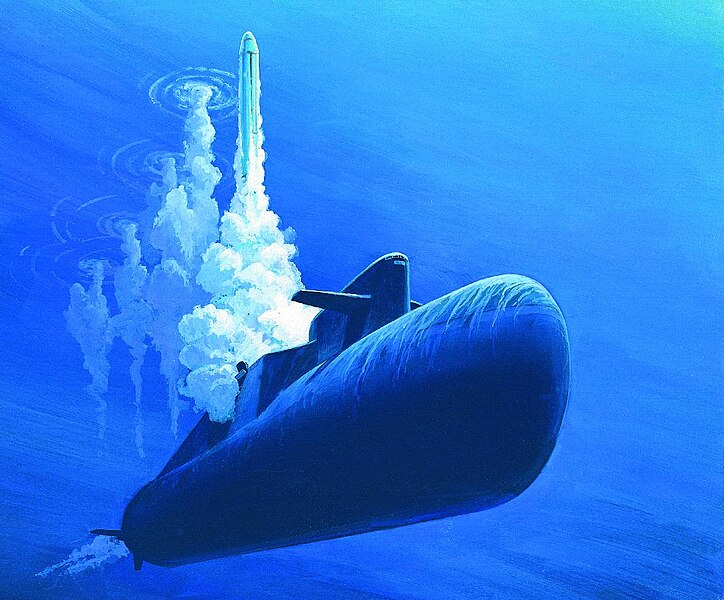
A rendition of Operation Behemoth
This was done by implementing original layout solutions, combining tanks of the last cruise and combat stages into the missile for compactness, using engines with best performance, new structural materials, improving technology, increasing the missile’s dimensions and even using volumes “borrowed” from the launcher. On paper, the 627BDRM planned missiles surpassed the US/UK Trident while having smaller weight and dimensions with a firing range of 8,300 km and a large payload.
The R-29RM was the last missile developed under V.P. Makeyev and last domestic liquid-fueled ICBM. This was was the swan song of liquid-propellant submarine ballistic missiles. All subsequent domestic SSBNs had solid fuel missiles.

The design was a further development of the Project 667 family and due to increased dimensions of the missiles, as the need to introduce new design solutions to reduce hydroacoustic signature, the height of the missile silo enclosure had to be increased again. The length of the bow and stern ends was also increased, and the diameter of the pressure hull increased as well; as well as the outer hull in the area of the 1st-3rd compartments, stretched out. The design of the pressure hull and the end of the inter-compartment bulkheads used steel obtained by electroslag remelting and possessing increased ductility.
When creating the Delfin, measures were taken to significantly reduces noise further. But also to reduce interference in operation, with parasiting of onboard hydroacoustic equipment. The principle of placing the powerplant on a cushioned common frame relative to the pressure hull was pushed further compared to the Delta III with an in all power compartments coated with sound absorbers and new acoustic coatings fitted on the outer hull and pressure hull as well. As a result, the new Delfing had unprecedented hydroacoustic signature characteristics, approaching the level of the 3rd generation SSBN “Ohio”, not a small feat in Soviet standards.
Design of the class

The 667BDRM project implemented measures to further improve the living conditions. The ship’s crew received a solarium, sauna, gym, etc. at their disposal.
The improved system of electrochemical air regeneration by electrolysis of water and absorption of carbon dioxide by a solid regenerating absorbent reliably provided an oxygen concentration of 25% and carbon dioxide no higher than 0.8%.
Powerplant
The main power plant of the submarine includes two VM-4SG water-cooled reactors (90 MW each) and two OK-700A steam turbines. The nominal capacity of the main power plant is 60,000 hp. On board the ship there are two TG-3000 turbogenerators, two DG-460 diesel generators, two fuel-efficient electric motors with a capacity of 225 hp each. The SSBN has low-noise five-bladed propellers (not on all ships) with improved hydroacoustic characteristics. To ensure the most favorable operating mode for the propellers, a special hydrodynamic device is installed on the light hull, equalizing the incoming water flow.
Armament
Main: 16 D-9RM SLBM
The D-9RM missile system was adopted for service in 1986 after the death of its creator, Viktor Petrovich Makeyev as a further development of the D-9R. This is the three-stage liquid-propellant R-29RM (ZM37, RSM-54) having a maximum range of 9,300 km (versus 6,500 km (4,038 miles) previously). The entire salvo can be launched from down to 55 m in one go whatever the sea state or weather.
The R-29RM missile was announced at the time by USSR as having the highest energy-mass ratio in the world. At 40.3 tons it was 5 tons heavyer than the previous Delta III missiles (35,3 tons) and a with a 2.8 tons payload equal to the much heavier Trident.
More so, it had the capacity to carry more MIRVs. The Delta III missile carried four of them whereas the payload head was more versatile and tailore to carry from four to ten warheads with a yield if ten were carried, of 100 kt. At present, the usual payload is four warheads or 250 kt each. Accuracy was much improved with a maximal deviation of 250 m (820 feet) comparable to the Trident Mark 5 (according to other estimates 170-250 m). Thus, the MIRVs can destroy small-sized highly protected targets such as enemy fixed silo launchers with intercontinental ballistic missiles, underground command posts and other bunkerized targets. The launch of the entire salvo could be carried out in a single salvo under max 55 m deep (180 m) without restrictions on weather conditions.
⚙ specifications R-29RM |
|
| Weight | 40,300 kg |
| Dimensions | 14.80 x 1.90 m, span 1.80 m |
| Propulsion | 3 stages solid |
| Speed | Supersonic in entry |
| Range | 9,300 km (5780 miles) |
| Guidance | Astro-inertial |
| Ceiling | Space |
| Accuracy | >1 km. |
| Payload | 2800 kg, 4x 250 kt or 10x 100 kt MIRV |
Upgrade: D-9RMU SLBM
In 1988, the complex was upgraded as the D-9RMU with the new R-29RMU SLBM. Warheads were replaced with more advanced ones, the navigation system was supplemented with space navigation equipment (GLONASS system) with the ability to launch missiles along flat trajectories, including from high latitudes to pierce missile defense systems. Resistance to damage from a nearby nuclear explosion was also increased. It ended with a new single-block super-powerful high-explosive fragmentation warhead of 2 tons (the mother of all HE warheads !). Such missiles are ideal in a context of conventional war to destroy very important stationary targets. Also, it was possible to give the warhead the capability of sending more of a new ultra-small (5-50 tons KTN) sub-MIRVs. That way, the 667BDRM can swap from nuclear deterrence into multipurpose tactical complexes adapted to all combat intensity.
Torpedoes
-SET-65:
7.8 m, 1.740 kg, 205 kg PL, Contact fuse 10 m radius mag. prox. fuse Active/passive acoustic seeker 800 m, Wire, twin prop wakeless 40 kt 16 km 400 m sub.
-SAET-60M:
7.8 m, 1.855 kg, 300 kg PL, same, no Wire guidance, 42 kt (13 km/42 kt, 15 km/35 kt)
-53-65K:
7.8 m, 2.070 kg, 307 kg PL, Active acoustic wake homing, 2TF turbine engine 44 kts RA 19 km, 100 m depth.
-53-65M:
7.95 m, 2.100 kgn 307 kg PL, Magn. prox. fuse, Active acoustic wake homing, 5DT-3 turbine 1.350 kW 44/70 knots, 14-24 km RA, 100 m depth.
URPK-6 Vodopad-PL SSM
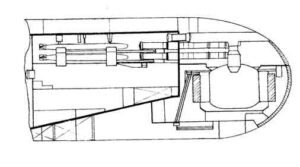 The РПК-6 Водопад, “waterfall” is a 533 mm ASW missile deployed since 1981 (SS-N-16 “Stallion”) with a solid-fuel rocket engine, dual-role to carry a 400 mm anti-submarine torpedo or nuclear depth charge. It was used in the 83R, 84R variants and brought a considerable reach in defence to these SSBNs. They were the first so-fitted, cmbined SAMs and SSM/ASuM missiles. Note that most 553 mm torpedoes had alternative nuclear warheads.
The РПК-6 Водопад, “waterfall” is a 533 mm ASW missile deployed since 1981 (SS-N-16 “Stallion”) with a solid-fuel rocket engine, dual-role to carry a 400 mm anti-submarine torpedo or nuclear depth charge. It was used in the 83R, 84R variants and brought a considerable reach in defence to these SSBNs. They were the first so-fitted, cmbined SAMs and SSM/ASuM missiles. Note that most 553 mm torpedoes had alternative nuclear warheads.
Development started in December 1969, lead developer was OKB Novator (OKB-8) but it was only Adopted by the Navy in 1981. Once ejected to the surface, the missile turns on its solid-fuel jet engine, left the water and flew to its designated target, then the rocket drops its warhead, landing by parachute, and the 400-mm UMGT-1 electric torpedo could home to range at 8 km, down to to 500 m at 41 knots. Full data
⚙ specifications URPK-6 Vodopad-PL |
|
| Weight | Unknown, c1800 kgs |
| Dimensions | |
| Propulsion | Solid rocker booster |
| Range/speed setting | 50 km (22 nmi) |
| Warhead | Nuclear depth charge or 400 mm torpedo |
| Guidance | Inertial guidance |
Sensors
 For centralized control of all types of combat activities, the submarine is equipped with the Omnibus-BDRM combat information and control system, which collects and processes information, solves problems of tactical maneuvering and combat use of torpedo and missile-torpedo weapons.
For centralized control of all types of combat activities, the submarine is equipped with the Omnibus-BDRM combat information and control system, which collects and processes information, solves problems of tactical maneuvering and combat use of torpedo and missile-torpedo weapons.
The SSBN is equipped with a new SKAT-BDRM hydroacoustic system, which is not inferior in its characteristics to American analogues. It has a large-sized antenna with a diameter of 8.1 m and a height of 4.5 m. For the first time in the practice of domestic shipbuilding, the 667BDRM project uses a fiberglass antenna fairing with a ribless design (this made it possible to reduce hydroacoustic interference affecting the antenna device of the complex). There is also a towed hydroacoustic antenna, retractable into the hull when not in use.
The Shlyuz navigation system ensures the necessary accuracy of missile weapon use. The 667BDRM project submarine is equipped with a radio communications system that allows the
cruiser to be controlled in virtually any combat conditions.

Colored, shadowed profile by Mike1979russia, CC
⚙ Delta IV specifications |
|
| Displacement | Surfaced 13,500 tons, Submerged 18,200 tons |
| Dimensions | 166 x 12.3 x 8.7m (545 x 40 x 29 ft) |
| Propulsion | OK-700A (two VM-4S (2*90 MW) PWR), 2 steam turbines: 44,700 kW (59,900 shp) |
| Speed | 14 knots (26 km/h; 16 mph) surf. 24 knots (44 km/h; 28 mph) sub. |
| Range | Unlimited, 90 days food supplies |
| Armament | 16× RSM-50 R-29R “Vysota” SLMBs, 4× bow 533 mm TTs (16 torpedoes) |
| Sensors | MRK-50 Kaskad, MGK-400 Rubikon, MRP-10M Zaliv-P, MG-44 Korund-1, Almaz-BDR CCS |
| Depth | Normal 320 m (1,050 ft), max 400 m (1,300 ft) |
| Crew | 40 officers, 90 enlisted |
Missile upgrades: Project 09787 (1999)

“Delta IV stretch”, NATO denomination for a converted SSN
In order to maintain their combat potential at the required level, a commission met in September 1999 under Vladimir Putin to decide to resume production of RSM-54 missiles, on a programme calculated for five years. The upgrade was made in cooperation with the Makeyev State Rocket Center, Miass and Zlatoust Machine-Building Plants, as well companies in Krasnoyarsk.
The service life of the R-29RM (R-29RMU) SLBM thus exceeded the maximum service life of its own warheads. In view of this, the “Station” project was carried out to adapt these missiles to a new medium-power MIRV with increased safety and improved accuracy in 2002.
K-64 had mid-refits turned into a conversion a special-purpose submarine in 1999, sometimes referred as project in western sources, but it is not official. From 2012, she had her missile compartments cut out is undergoing conversion in Severodvinsk. The volume of work performed and the timeframe for completion remains classified.
D-9RMU2 “Liner” complex uprade

From 1996 to 2011, the six remaining 667BDRM were modified to carry the new D-9RMU2 missile system and Sineva SLBM. According to the Kommersant in 2012, the intercontinental ballistic missile R-29RMU2 Sineva has a three-stage missile, being designated RSM-54M, or according to NATO classification, SS-N-23 SKIFF. it was developed by the Academician V.P. Makeyev State Rocket Center in 1998-2007. It had a new control system with a missile defense penetration system, and new satellite navigation system. More important, the new Sinelva can carry up to ten MIRVs of setup yeld made before the launch in order to perform all sorts of strikes fro limiuted tactical ones at very low yelds to massive city-levellers ones.
The missile weighs 40 tons, with a firing range of 11,000 km with 2.8 tons of payload. It is planned to keep the R-29RMU2 SLBM active as long as possible. It is not cmpatible with the Borei class tubes which carries the new and larger RSM-56 Bulava.
In 2009–2011, the V.P. Makeyev State Research Center went on improving the missile leading to the R-29RMU2.1 capable of using mixed configuration of warheads of different power classes and even more efficient anti-missile defense systems. In an interview with RIA Novosti, the Russian CiC Vladimir Vysotsky said:
The does not need to be accepted into service, it is an existing missile that is undergoing modernization in terms of combat equipment. In the future, all our active strategic submarines will be equipped with these missiles.
According to experts, rearmament with this new complex called “Liner” could be done in 2025 to give them extra relevance until 2030.
Career of the Delta IV
According to experts, the Delta IV or Dolphins as known stll in Russia were the most successful SSBNs ever built in USSR. Although impressive, the Typhoons were seen as white elephants pushed by the party and which had a lot of issues. The end result was that none survived the collaspe of the USSR. They were very costly to maintain and a pure product of the 1980s new missile crisis at the end of the cold war. Dolphins remaining in service are in good technical condition and well suited still for today’s Russian fleet needs, in fact all are in the northern fleet, alongside the brand new Borei… When the remaining Borei-A would be completed the new Delta IV will probably be removed from service. After all, K407, the last built, is now 34 years old and maintenance gets complicated. No retirement date has been announced for the moment, which is understandable within the current context, but experts believes 2030 is a probable red line, with reserve afterwards.
 K-51 (Later K-84, Verkhoturye)
K-51 (Later K-84, Verkhoturye)
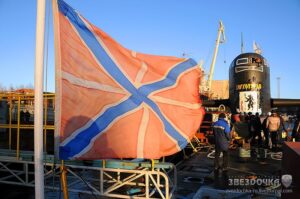 Note: Only K51 will be treated in detail here as an example. Check deepstorm and other sources cited below for more. On 1981 February, 23,, she was laid down at Sevmash in predpriyatie yard, Severodvinsk and called the lead ship of the serie Delfin. On May 21 she is listed as SSBN in he fleet register, and in March 7, 1984, she is Launched. In June 12, 1984 the nuclear reactors was tested, and from August to December she had mooring and sea trias with state tests completed, and flight tests for the missile complex carried out at the same time from the ground then underwater launches on 29 and 30 october, then 16, 17, 27 and 30 november. This was with two missiles on 19 December and she launched her first four missiles salvo on 26 December 1984.
Note: Only K51 will be treated in detail here as an example. Check deepstorm and other sources cited below for more. On 1981 February, 23,, she was laid down at Sevmash in predpriyatie yard, Severodvinsk and called the lead ship of the serie Delfin. On May 21 she is listed as SSBN in he fleet register, and in March 7, 1984, she is Launched. In June 12, 1984 the nuclear reactors was tested, and from August to December she had mooring and sea trias with state tests completed, and flight tests for the missile complex carried out at the same time from the ground then underwater launches on 29 and 30 october, then 16, 17, 27 and 30 november. This was with two missiles on 19 December and she launched her first four missiles salvo on 26 December 1984.
That same dzay she was accepted for service, commissioned with a certificate signed by the Navy CiC. On 30 December 30 the official commission ceremony takes place and the naval flag is raised, the wiht full acceptance into the Navy. The date was declared an annual holiday for her.
On January 1, 1985 she arrived at her homeport of Olenya Bay; Murmansk-62 and on March 4, was integrated into her unit, the 13th Submarine Flotilla of the 3rd Submarine Fleet, Olenya Bay, Murmansk.
On July 26, 1985 she launched two ballistic missiles from her max submerged position and between August and September she completed her first long-range patrol, with her first crew with senior officer on board, the 13th Submarine Fleet Commander Rear Adm. V.P. Agafonov. She reached 82° Noth and sailed under ice to test there the missile system with no combat missiles on board just cargo mock-ups missiles.
On January, 8, 1986 she was visited by the Main Political Directorate of the Soviet Army and the Navy Colonel-General A.D. Lizichev. From August 28 to September 28 she made another cruise with the first crew and division’s commander, Capt. Berzin A.A., reaching 87° to test her Shlyuz navigation system. Flight tests of the R-29RM missile at the final testing stage were done until the D-9RM was accepted into service in late 1986.
On August 7, 1987 she made another final missile launch underwater. On 2-29 Sept. 1987 she eprformed her first full Arctic cruise with the first crew under captain Sugakov A.I.and commander Berzin leaving Severodvinsk with practice R-29RMU missiles for full-scale launches in joint flight tests in high-latitude regions of the Arctic. Civilian specialists from the Design Bureau (now Makeyev Design Bureau) were also on board to perform routine and pre-launch maintenance of the complex and record telemetry information. On 15.09 K-51 surfaced at the geographic point of the North Pole and at 17.09 launched two ballistic missiles (16.12 Moscow time) at Chizha combat field, Cape Kanin. They functioned normally, but as reported, the warheads did not fell as planned in their designated target area. As subsequent analysis showed, the cause was an improper assembly of the cable trunk cutoffs back at the plant. Thus led to the failure to separate the telemetry cables for communication between the missiles and silo complex and leading to a depressurization of the instrument compartments causing this abnormal flight. The cause was identified and measures taken.
The mission was joined with TK-12 missile launches by K-358 (Victor III).
From October to December 1987, she took part in the Development and flight tests of the new R-29RMU missile. From October to December, she made a total of 10 launched with 2 or 3 twin launches and three of single missiles, all successful leading to fully complete this upgrade program.
On 28 1987 November when entering the port of Severodvinsk, she proceeded aty the edge of the channel in the Dvina Gulf in poor Visibility but calm sea ad moderate wind speed of 8 m/sec when the “training alarm” was played as the crossed the narrow channel at 9 knots. At 12 am, the coastal radar station “SNAR-6” took over her pilotage and she turned off her radar. Due to an error by the radar operator, she shifted to the right by almost a mile and at 12:13 pm, the on board navigator doing manual dead reckoning reported to the commander his doubt about the course, although the commander only reduced the speed at 12:28 pm up to 5 knots without course correction. Two minutes later K-51 ran aground, 800 meters on the bank out of her designated channel. It was only at 18:15 that she was pulled off the sandbank by four rescue tugs and arrived into the port of under her own power, 2.5 hours later. A diving inspection found no damage. The captain after this was reported received a blame. She spend 1988 in maintenance.
From February 15 to April 26 1989 she made another patrol with the first crew under captain Sugakov and 1st group commander Makarov, under ice for 22 days.
In November 1989 she was awarded the Challenge Red Banners of the Murmansk Regional Committee, Northern Fleet and from the Autumn to Winter 1990 she made her first patrol with her second crew under captain 2nd group Grin E.F. and senior 1st group commander Tregubov, under ice for 8 days.
In the 1991 summer she made another patrol with second crew (captain Grin E.F., senior Cdr Berzin). On June 3 she was reoriented to a sub-class and by June 11 her honorary “Named after the XXVI Congress of the CPSU” was removed. 1991 was a maintenance year. The summer of 1992 saw her second crew swapped with K-407 making a ptrol under captain Grin and by 28 December 1992 she both crews wapped positions. On 1st March 1993 she was transferred to Zvezdoch yard in Severodvinsk for refit and modernization, provisionally transferred to the 400th Northern Fleet unit, cdr. Rusanov. This was a long process in very challenging conditions between 1993 and 1998.
The crew of of K-51 performed meanwhile various patrols on other delta IV boats. On 9 February 1999 she was to be renamed “Verkhoturye” and “Ekaterinburg”. But tiis was never made official. Sverdlovsk Region E. Rossel acceptedg veterans’ proposal to sponsor her and this was concluded on 19 February between the crew and representative, 1st rank captain B.I. Durtsev and the Government of the Sverdlovsk Region A.P. Vorobyov.
On 28 March 1999 she was officially renamed “Verkhoturye” and on 23 August arrived in Severodvinsk to receive her test crew, performed from September 10 and from October 20 her reactors were tested, in November her mid-life modernization was signed complete. On 18-28 November 1999 she performed her sea trials and on 2-5 December completed her last sea trials, last leg on 7-17 December, further sea tests by June 2000 and in July a cruise to Sayda Bay.
On September 2000 she was reassigned to the 31st Red Banner Submarine Division, 3rd Submarine Fleet, Northern Fleet in Yagelnaya, Sayda Bay close to Gadzhiyevo.
In June 2001 she made her first missile launch from the Barents Sea underwater and it was successful, the warhead hitting the target at the Kura test site in Kamchatka.
By September 2002 her division was reformed into the 12th one and in 2002 she was awarded the Navy CiC Prize for successfully firing missiles. Spring 2003 spring saw her first patrol with the first crew of K-117 under captain Rachuk S.V. and in Sept. 2005 her made another under captain Domnin S.V., and senior Cdr Ryabukhin A.V. In late 2006 she was to take part in special exercises of the naval strategic forces with eight submarines of the Northern and Pacific fleets combined in a tactical group.
By 2006 she had completed 8 patrols, including 4 under Arctic ice, 10 combat sorties, 17 missile launches and by June 13-14 2009 she conducted two launches of the new RSM-54 intercontinental ballistic missiles shared with K-84 Yekaterinburg and K-117 Bryansk. K-51 Verkhoturye (commander 1st class Domnin S.V. commanded her at the Kura (Kamchatka) and Chizha (White Sea) test sites.
June-August 2009 saw a patrol joint with K-117 “Bryansk”, her crew being awarded the title of “best in the Northern Fleet”. August 23 2010 saw her in rfit at Zvezda’s Ship Repair Center JSC for technical readiness restoration mode. The goal was to extend her servive life by 5 years but it was postponed until funding began. Still not started by December 2010 and resumed then completed by March 24, 2012. By November 22 she amde post-refit trials in the White Sea and fixes at Zvezda. All systems were tested and certified off Gadzhiyevo, Murmansk Oblast.
The acceptance certificate was signed on December 30 in a ceremony attended by the Russian MoD Yuri Borisov and CiC Alexander Tatarinov, DNC Leonid Strugov and membered of the government such as Vladimir Pospelov and Andrey Dyachkov. By July 2013 she was featured in the Polygon documentary “Journey to the Depths” directed by M. Ivanov and I. Yakovlev with the 2nd crew under captain Golovko K.V. on board. By July 28, 2013 she took part in the naval parade on Navy Day at the Severomorsk roadstead with 2nd crew on board.
In july 2015 she was in a naval parade in honor of Navy Day in Severomorsk again and by December 12, 2015, tere was a swap of crews under Dmitry Zelikov, commander of the first crew of the submarine “Ekaterinburg” on K-84 Verkhoturye. They launched the Sineva missile from the designated area in the Barents Sea to the Kura test site in Kamchatka. This was the 27th successful launch of her career. By july 2017 she took part in the yearly naval parade in Severomorsk and by March 2018 March took part in a fleet training session under fleet commander Admiral Nikolai Evmenov.She under the best results under command of Capt. A. Plotnikov. In July 2022 she took part in the yealy naval parade in Severomorsk and by 2023 was still listed in the 31st submarine force of the Northern Fleet based in Yagelnaya Bay, Sayda Bay. As for now she is noted as active with upgraded Sineva missiles installed.
 K-84 (Ekaterinburg)
K-84 (Ekaterinburg)
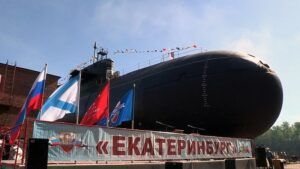 K-84 was also built at SEVMASH in Severodvinsk and post-USSR was renamed Ekaterinburg. Laid down on 17 Feb 1982, launched on 17 Mar 1985 and completed on 30 Dec 1985 she was assigned to the northern fleet, and she had the upgraded Sineva missiles installed after her overhaul in 2011–14. It was delayed as on 29 Dec 2011 a fire broke out while she was drydocked, and partially submerged to control the fire. She was re-commissioned in Dec 2014. it seems the damaged was such she was eventually decommissioned in 2020.
K-84 was also built at SEVMASH in Severodvinsk and post-USSR was renamed Ekaterinburg. Laid down on 17 Feb 1982, launched on 17 Mar 1985 and completed on 30 Dec 1985 she was assigned to the northern fleet, and she had the upgraded Sineva missiles installed after her overhaul in 2011–14. It was delayed as on 29 Dec 2011 a fire broke out while she was drydocked, and partially submerged to control the fire. She was re-commissioned in Dec 2014. it seems the damaged was such she was eventually decommissioned in 2020.
 K-64 (Podmoskovye)
K-64 (Podmoskovye)
BS-64 (ex K-64) was laid down on 18 Dec 1982, launched on 2 Feb 1986 and completed on 23 Dec 1986, assigned to the Northern Fleet. In 1999–2016 she was converted under the Project 09787 special purpose platform with brand new missile silos in order to test new ballistic missiles. Still listed as active.
 K-114 (Tula)
K-114 (Tula)
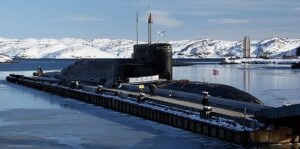 K-114 was laid down at SEVMASH, on 22 Feb 1984, launched on 22 Jan 1987 and completed on 30 Oct 1987, assigned to the Northern Fleet and in overhaul between 2014 and 2017, then returned to active duty in December 2017, and upgraded Sineva missiles installed.
K-114 was laid down at SEVMASH, on 22 Feb 1984, launched on 22 Jan 1987 and completed on 30 Oct 1987, assigned to the Northern Fleet and in overhaul between 2014 and 2017, then returned to active duty in December 2017, and upgraded Sineva missiles installed.
 K-117 (Bryansk)
K-117 (Bryansk)
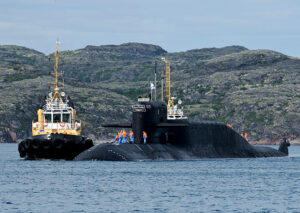 K-117 was laid down on 20 Apr 1985, launched 8 Feb 1988 and completed on 30 Sep 1988, assigned to the Northern fleet. She had an overhaul 2002–08, for the Sineva missiles and various refits to extend her service life by 3.5 years made in 2018-2020. Listed as active.
K-117 was laid down on 20 Apr 1985, launched 8 Feb 1988 and completed on 30 Sep 1988, assigned to the Northern fleet. She had an overhaul 2002–08, for the Sineva missiles and various refits to extend her service life by 3.5 years made in 2018-2020. Listed as active.
 K-18 (Karelia)
K-18 (Karelia)
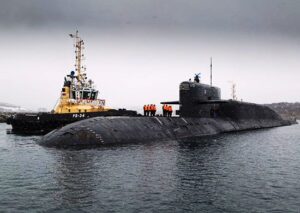 K-18 was laid down on 7 Feb 1986, launched 2 Feb 1989, completed on 10 Oct 1989, assigned to the Northern fleet, overhauled in 2004–10 and upgraded to the Sineva missile complex. Listed as active today.
K-18 was laid down on 7 Feb 1986, launched 2 Feb 1989, completed on 10 Oct 1989, assigned to the Northern fleet, overhauled in 2004–10 and upgraded to the Sineva missile complex. Listed as active today.
 K-407 (Novomoskovsk)
K-407 (Novomoskovsk)
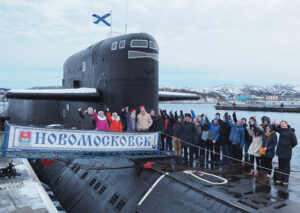 K-407 was laid down on 2 Feb 1987, launched on 28 Feb 1990 and completed on 27 Nov 1990, she was assigned to the Northern fleet. She had an overhaul modernization in 2008–2012, with the Sineva missile upgrade. Listed as active, decommission expected c2030.
K-407 was laid down on 2 Feb 1987, launched on 28 Feb 1990 and completed on 27 Nov 1990, she was assigned to the Northern fleet. She had an overhaul modernization in 2008–2012, with the Sineva missile upgrade. Listed as active, decommission expected c2030.
Read More/Src
Kuzin V.P., Nikolsky V.I. “The USSR Navy 1945-1991”, IMO, St. Petersburg, 1996.
Apalkov Yu.V. “Submarines”, v.1, part 1, Galeya Print, St. Petersburg, 2002.
Ilyin V.E., Kolesnikov A.I. “Submarines of Russia: Illustrated Handbook”, Astrel, AST, 2002.
Berezhnoy S.S. “Nuclear Submarines of the USSR and Russian Navies”, MIA No. 7, 2001.
“Domestic Submarines. Design and Construction” under the general editorship of Academician of the Russian Academy of Sciences V.M. Pashin, Central Research Institute named after academician A.N. Krylova, St. Petersburg, 2004.
Evseev V.V. “The fleet is being equipped with another formidable nuclear club”, NVO 10.02.2012 (http://nvo.ng.ru/armament/2012-02-10/8_flot.html)
Spirikhin S.A. “Surface ships, vessels and submarines built by plant No. 402 – SMP (1942-2001)”, Pravda Severa, Arkhangelsk, 2004.
Books
Conway’s all the world fighting ships 1947-1995
Links
globalsecurity.org 667bdrm.htm
hazegray.org/ submar.htm#ssbn
www.naval-technology.com delta-class-submarine/
en.wikipedia.org Delta_IV-class_submarine
On deepstorm.ru
fas.org/ submarine-upgrades-russia/
en.wikipedia.org/wiki/R-29RM_Shtil
web.archive.org/ aeronautics.ru/667.htm
lynceans.org Russia_submarines.pdf
russianships.info project_671
Videos
See also inside a Delta IV
Model Kits
General query on scalemates
Project 667BDRM Delfin – Tula NATO Delta IV Class Zvezda 1:350 and Russian Nuclear Powered Ballistic Submarine K-407 Novomoskovsk NATO Delta IV Class Alanger 1:350
Delta III Class Submarine Polar Bear 1:350, Project 667 BDR Kalmar (NATO name Delta III) OKB Grigorov 1:1200.
U-Boot mit ballistischen Raketen Tula Ballistic missile submarine Tula Zvezda 1:350 by Manuel González
http://scalemodels.ru/modules/myarticles/imagepreview.php?id=1184&image=1223590132_6670005.jpg


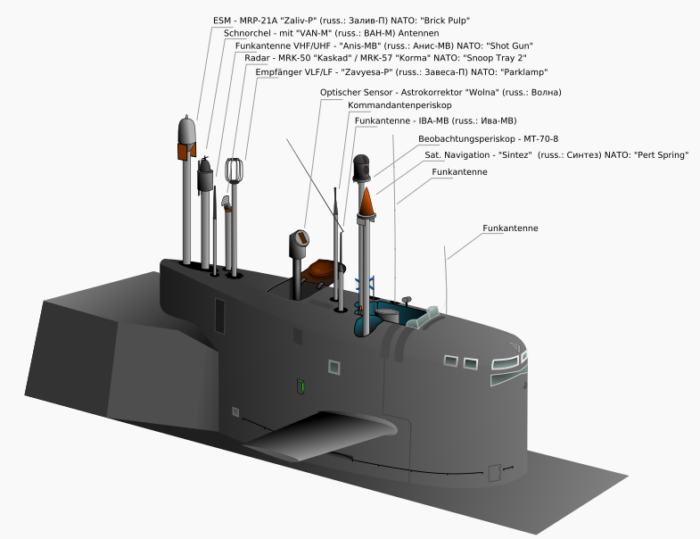
 Latest Facebook Entry -
Latest Facebook Entry -  X(Tweeter) Naval Encyclopedia's deck archive
X(Tweeter) Naval Encyclopedia's deck archive Instagram (@navalencyc)
Instagram (@navalencyc)





 French Navy
French Navy Royal Navy
Royal Navy Russian Navy
Russian Navy Armada Espanola
Armada Espanola Austrian Navy
Austrian Navy K.u.K. Kriegsmarine
K.u.K. Kriegsmarine Dansk Marine
Dansk Marine Nautiko Hellenon
Nautiko Hellenon Koninklije Marine 1870
Koninklije Marine 1870 Marinha do Brasil
Marinha do Brasil Osmanlı Donanması
Osmanlı Donanması Marina Do Peru
Marina Do Peru Marinha do Portugal
Marinha do Portugal Regia Marina 1870
Regia Marina 1870 Nihhon Kaigun 1870
Nihhon Kaigun 1870 Preußische Marine 1870
Preußische Marine 1870 Russkiy Flot 1870
Russkiy Flot 1870 Svenska marinen
Svenska marinen Søværnet
Søværnet Union Navy
Union Navy Confederate Navy
Confederate Navy Armada de Argentina
Armada de Argentina Imperial Chinese Navy
Imperial Chinese Navy Marinha do Portugal
Marinha do Portugal Mexico
Mexico Kaiserliche Marine
Kaiserliche Marine 1898 US Navy
1898 US Navy Sovietskiy Flot
Sovietskiy Flot Royal Canadian Navy
Royal Canadian Navy Royal Australian Navy
Royal Australian Navy RNZN Fleet
RNZN Fleet Chinese Navy 1937
Chinese Navy 1937 Kriegsmarine
Kriegsmarine Chilean Navy
Chilean Navy Danish Navy
Danish Navy Finnish Navy
Finnish Navy Hellenic Navy
Hellenic Navy Polish Navy
Polish Navy Romanian Navy
Romanian Navy Turkish Navy
Turkish Navy Royal Yugoslav Navy
Royal Yugoslav Navy Royal Thai Navy
Royal Thai Navy Minor Navies
Minor Navies Albania
Albania Austria
Austria Belgium
Belgium Columbia
Columbia Costa Rica
Costa Rica Cuba
Cuba Czechoslovakia
Czechoslovakia Dominican Republic
Dominican Republic Haiti
Haiti Hungary
Hungary Honduras
Honduras Estonia
Estonia Iceland
Iceland Eire
Eire Equador
Equador Iran
Iran Iraq
Iraq Latvia
Latvia Liberia
Liberia Lithuania
Lithuania Mandchukuo
Mandchukuo Morocco
Morocco Nicaragua
Nicaragua Persia
Persia San Salvador
San Salvador Sarawak
Sarawak Uruguay
Uruguay Venezuela
Venezuela Zanzibar
Zanzibar Warsaw Pact Navies
Warsaw Pact Navies Bulgaria
Bulgaria Hungary
Hungary

 Bundesmarine
Bundesmarine Dutch Navy
Dutch Navy Hellenic Navy
Hellenic Navy Marina Militare
Marina Militare Yugoslav Navy
Yugoslav Navy Chinese Navy
Chinese Navy Indian Navy
Indian Navy Indonesian Navy
Indonesian Navy JMSDF
JMSDF North Korean Navy
North Korean Navy Pakistani Navy
Pakistani Navy Philippines Navy
Philippines Navy ROKN
ROKN Rep. of Singapore Navy
Rep. of Singapore Navy Taiwanese Navy
Taiwanese Navy IDF Navy
IDF Navy Saudi Navy
Saudi Navy Royal New Zealand Navy
Royal New Zealand Navy Egyptian Navy
Egyptian Navy South African Navy
South African Navy






























 Ukrainian Navy
Ukrainian Navy dbodesign
dbodesign